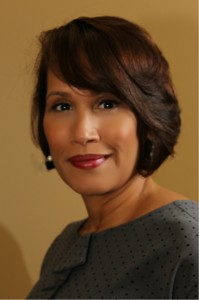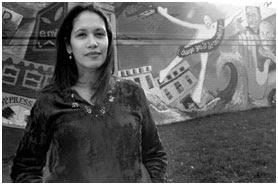Proctor Creek Conversation with Alexie Torres-Fleming: My Takeaway
Dr. Yomi Noibi, Executive Director, ECO-Action
 How do community members with little money, power or education organize to create positive, deep and meaningful transformations in their neighborhood which has for years been treated with “benign neglect”? About 30 people from federal, state, local government agencies, non-profit organizations and community-based organizations engaged in restoring and protecting Northwest Atlanta’s Proctor Creek watershed, listened to Alexie Torres-Fleming, a community organizer share how she worked with members of her community in the South Bronx to restore sections of the Bronx River into an environmental oasis in the midst of the South Bronx, New York. Her talk took place at the Atlanta Food Bank on March 24, 2015.
How do community members with little money, power or education organize to create positive, deep and meaningful transformations in their neighborhood which has for years been treated with “benign neglect”? About 30 people from federal, state, local government agencies, non-profit organizations and community-based organizations engaged in restoring and protecting Northwest Atlanta’s Proctor Creek watershed, listened to Alexie Torres-Fleming, a community organizer share how she worked with members of her community in the South Bronx to restore sections of the Bronx River into an environmental oasis in the midst of the South Bronx, New York. Her talk took place at the Atlanta Food Bank on March 24, 2015.
As I listened, I was filled with the humanity, transparency, and candidness with which Alexie shared her transformation, from a woman who did not recognize her power or place in her community to one who did. Alexie is only the second person who touched this core of my being as a community organizer. The first was Carol Williams, co-founder of ECO-Action. Both of them truly live their values and beliefs.
During her talk, Alexie who now serves as the Executive Director of the Access Strategies Fund shared several salient points that will be crucial to the success of our concerted efforts in working together to restore, revitalize and protect Proctor Creek. I would like to briefly outline my take aways from Alexia’s conversation with us.
According to Alexie, to build an authentic organization with dignity and collaboration, we need to live in love. As a community, love belongs to one another. My take way from this is we need to show love to one another, even to our opponents/enemies. Yes, even to the person that patronized you, cheated you and lied to you. This is living in love and with mutual respect for ALL.
 Identifying what is good in the people and place (rather than just the problems) is essential. This is the essence of community asset mapping. Young Alexie lived close to Bronx River as a child but she did not know it. The river had the potential to be a community asset, but the community didn’t know it. Alexie had to go outside her place to discover the good in the place that she lived. That was her journey. Where are you in your journey of appreciating and loving the people and place you live? My take away is that when we identify the assets together, we allow our community members to dream dreams for the place they live.
Identifying what is good in the people and place (rather than just the problems) is essential. This is the essence of community asset mapping. Young Alexie lived close to Bronx River as a child but she did not know it. The river had the potential to be a community asset, but the community didn’t know it. Alexie had to go outside her place to discover the good in the place that she lived. That was her journey. Where are you in your journey of appreciating and loving the people and place you live? My take away is that when we identify the assets together, we allow our community members to dream dreams for the place they live.
Alexie’s explanation of the “inside and outside strategy” of coalition building was a big take way for me. Her community was on the outside of established networks of power and so they had to cultivate relationships with people inside of those networks. [su_pullquote]We too must learn to train our wisdom and expertise to serve the Proctor Creek community.[/su_pullquote]While partners inside could use the resources they had within the constraints of their organizations, her groups could work outside the box and call elected officials to task, often through public spectacle and protests. The inside relationships are about authentic partnership and collaborations, which are growing within the Proctor Creek Stewardship Council (PCSC). Her folks had to grow in capacity to engage and affect the “inside” strategy. We too must learn to train our wisdom and expertise to serve the Proctor Creek community. In the process of doing this, we will demystify the systems and the language of communication with one another. Simply put, we become more real and more transparent with one another.
How do we position ourselves to build relationships that are more transformational and less transactional in our community organizing and coalition building? [su_pullquote align=”right”]As our community organizing and coalition building for environmental protection is filled with love, hope, fortitude and fun, we must appreciate the power in this process.[/su_pullquote]We position ourselves by working out of love, showing mutual respect for all, and believing that the work we are doing to restore, revitalize and protect Proctor Creek is bigger than ourselves. This is another element of the inside /outside strategy. Let us reflect on what Alexie meant when she said, ”We need each other at both the professional level and individual level”. When we know each other on both levels, we are seeing each other as human beings. Our walk and work help us to share power, talent, time, and money out of our humanity. As our community organizing and coalition building for environmental protection is filled with love, hope, fortitude and fun, we must appreciate the power in this process.
What were your take ways from Alexie’s conversation with the Proctor Creek community?
Alexie’s talk rekindled my spirit to keep fighting the good fight for the stewardship of Proctor Creek. More stewards are needed to sustain the restoration, revitalization, and protection of the creek. As we engage in the fight, we have to fight wiser and smarter at all levels of engagement. If we imagine the Council at a canoe floating on Proctor Creek, we see that we won’t be able to enjoy the Creek for long if the canoe is filled with holes. We work smarter if we each work to fill the holes that are already in the canoe and strive not to create any new ones.
I found Alexie to be an extraordinary and impactful community builder whose work is informed and guided by love and love for humanity. I want to thank American Rivers, The Conservation Fund, Park Pride, and Proctor Creek Stewardship Council & West Atlanta Watershed Alliance for sponsoring this conversation.
